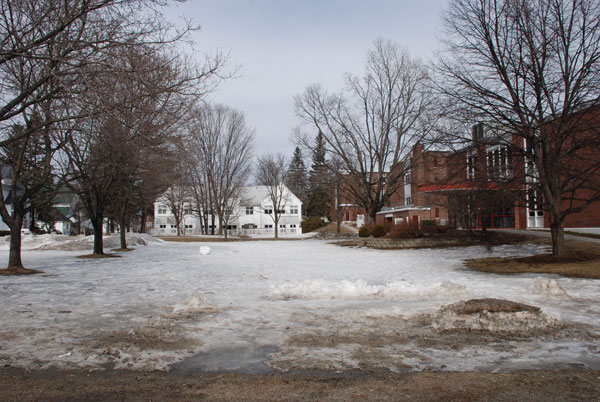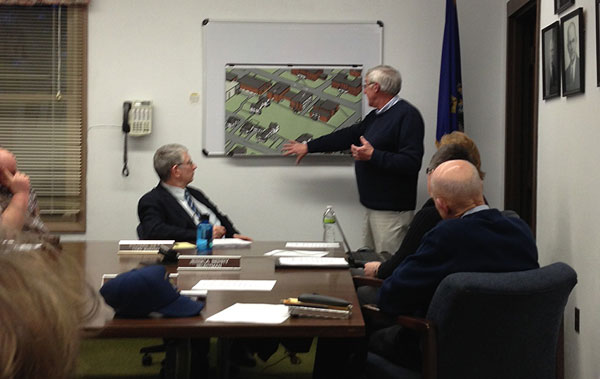
FARMINGTON – In two months time, a big construction project will begin in the heart of the University of Maine at Farmington campus that is expected to save upwards of 30,000 gallons of fuel oil each year.
In the largest geothermal heating and cooling system project on campus yet, 80 wells will be dug to depths reaching 500 feet for a system of pipes to be installed in the green area in front of Mantor Library. The work is set to begin on May 19, the day after UMF’s graduation ceremony, and is expected to be completed by Aug. 30, the day before students arrive back to start classes, Ben Pratt, UMF’s director of facilities management, told selectmen at a recent meeting.
Last month, University Maine Board of Trustees approved up to $1.55 million for the geothermal well field as part of the university’s goal of reaching carbon neutrality by 2035.
In 2010, former UMF president Theodora Kalikow announced a climate action plan that was developed over a decade by the Sustainable Campus Coalition. The coalition of students, faculty, staff and community members, works to educate the public on green matters while finding ways to reduce the environmental impact of campus operations.
The new geothermal closed-loop system will be hooked up to Preble Hall, Thomas Auditorium and Ricker Addition, for a total 50,000 square foot of building space that is currently heated by oil. The cost savings of fuel each year will provide a payback of the entire system within eight or 10 years, Pratt said.
Geothermal well system provides for heat exchange to take place under the relatively constant temperatures underground then pumps the heated or cooled air back into the building. UMF’s Education Center, the Fitness and Recreation Center’s pool and the newest building on campus, the Emery Community Arts Center, all use a geothermal system.
For construction of the 80 wells, the maple trees that line the campus quad will be taken out for the excavation, drilling, sand bed and well installation and back fill to be completed. Pratt estimates that 6,000 cubic yards of fill be removed, screened then put back to fill in the wells. The access road between Preble Hall and Manor library off High Street will be the primary route used by trucks.
Although South Street will also be used to access the construction site, Pratt said the contractor, Skillings and Son of Nashua, N.H., plan to keep the street open most the time with use of flaggers. Of the total construction cost, $114,000 has been set aside for repaving any damaged town roads or sidewalks from the project.
The construction site will be surrounded with a chain link fence and pedestrian traffic will be circumvented around the entire area. The project’s progress will be posted on the fence so observers can be informed of what’s going on.
“It will be an active classroom,” Pratt said. Future plans call for adding campus buildings facing Main Street, Mantor Library and the Computer Center to the system for an estimated total savings of 70,000 gallons of heating fuel each year.






Interesting. They could have saved thousands of gallons already by either upgrading the insulation of the Olsen Student center or tearing it down and building a better structure. That building is one of the most thermally inefficient structures in the state.
The University pretends to be all greenie, when in reality all they do is spend tax dollars and raise tuition.
It is so exciting to see the advancement of alternative energy on campus. I am sure it will provide many learning experiences for the college population and the community as well. My deepest hope is that in these hard economic times, there will be opportunity for local Maine contracters as well as local construction workers.
I thought UMF was going to be part of the natural gas user program? What happened to that?
Being “carbon neutral” is a good idea – truly . But I just luv the studies done by some of the students a couple of years back – pointing the finger at the Town of Farmington – their host town, and pointing out all the places the Town of Farmington could reduce their carbon footprint. The study’s biggest concern was the carbon emissions of the Highway Dept. Okay…that’s very true. So if carbon emissions from the Highway Dept. is such a “bad thing”, perhaps the town should avoid plowing the streets in town. Who’d be the first to complain? The students! And unless they’re ready to man a shovel to clear the streets, perhaps they should worry more about getting better grades than pointing a finger at the town who spends MILLIONS to make the streets passable, to pay for street lights to keep them safe, and to pay the fire hydrant rent to protect their buildings.
Having UMF here is NOT CHEAP for the tax payers. NOT CHEAP at all.
Oh come now…, lets not start another round of “Gown Bashing”. As a former business person & employer in Farmington, it was & still is clear that we are amazingly fortunate to be a “College Town”. The scores of local people that our vibrant downtown and surrounding business community supports economically generates a massive ripple effect felt across this county. Without our local college, our community could easily resemble many a Maine town currently struggling to find ways of filling empty storefronts along “Main St.”. While we may have to collectively provide services to the college which may not be “cheap” as you say, the economic balance sheet is clearly in the community’s favor. I applaud UMF”s leadership in green technology. As voters lets not forget that we have also made great strides in reducing our carbon footprint at several school facilities in RSU 9. Projects that were also “costly” but promise great savings & use locally produced renewable resources. Ultimately it will be up to each & every one of us to find ways of saving energy. Geothermal projects like this, at the very least, remind us of that responsibility & may influence me, you or your neighbor to consider the energy use of any our own future purchase or building project.
I for one am not interested in the natural gas option, nor any of the dangers and health hazards that go along with it. Polluted soils, contaminated drinking water, sinkholes, and fires. Not to mention the permanently changed landscape. The health and environmental COST is not worth it. Good for UMF doing what it can do with geothermal energy.
One fact is glaringly absent from all this. How much will the electric usage increase? It will certainly increase as there are pumps constantly running to circulate the water.
geothermal _seismicity_protocol_012012.pdf – Adobe reader
U.S. DOE
when they say a geothermal field, does that mean the lawn green space is gone?
Ben Pratt said after the geothermal well field is installed and filled back in, it will be returned to a green lawn space. He suggested it might then be where graduation ceremonies could be held, instead of the current computer center parking lot.
Looks more like 16 years payback to me (maybe my math is flawed) not to mentioned the increased electricity use. Most of these projects leave the occupants cold.
When considering heat pump, vs geothermal heat pump, vs natural gas, vs oil, and then tossing in heating and air conditioning, please consider the whole energy system when looking at glaringly left out data.
Of course geothermal heat will use more electricity than oil, gas, pellet, or wood chip. Of course geothermal does not have to buy mainly oil, gas, pellets or wood chips.
What geothermal does is increase the benefit of the electricity that is consumed by pumping heat out of the earth in the winter, and pumping heat into the earth in the summer.
Heat pump operations tend to get about 2 to 2.5 times as much energy moved, than electricity consumed. Thats like doubling or more the miles per gallon you get from your car!
The pay back period listed above suggests a very efficient system. Maybe someone from the design team, or project management team would post the expected efficiencies of this source for heating and cooling, vs oil and traditional air conditioning…a little direct technical details to share with the public so more of us can judge for ourselves as we retrofit homes and businesses over time.
Gas may be a great option IF it arrives via pipline, but I bet the cost comparison when including air conditioning leans towards geothermal.
This is a great project and it will PAY for ITSELF…thanks for going forth UMF.
It surprises me that the people in higher education can’t do math. Paybacks on grand geothermal instalations in this part of Maine run in the 16-20 year range. I wonder how much oil has been saved with the millions they have already spent. I bet you will find it is a pretty small amount compared to the investment. Rumors are that the buildings served by geo are too cold to be comfortable. NG has a great pay back over #2 fuel but is probably at best 8-10 years out for Farmington. UMF should take a page from the surrounding k-12 schools that seem to much better at math and put in some biomass boilers (chips-pellets) they are green, show a payback in much less time, (usually 5-10years) and support the local economy.